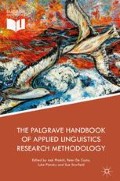Abstract
This chapter explains how exploratory factor analysis (EFA) is used to explore common factors that account for participants’ responses to research instruments, such as Likert-type scale questionnaires and tests. It provides an overview of important aspects, considerations and practical guidelines for conducting EFA. This chapter compares and contrasts some differences and similarities among EFA, confirmatory factor analysis and principal component analysis. Key steps for EFA are presented through the use of IBM SPSS (Statistical Package for Social Sciences).
Access this chapter
Tax calculation will be finalised at checkout
Purchases are for personal use only
References
Asención-Delaney, Y., & Collentine, J. (2011). A multidimensional analysis of a written L2 Spanish corpus. Applied Linguistics, 32(3), 299–322.
Bond, T. G., & Fox, C. M. (2007). Applying the Rasch model: Fundamental measurement in the human sciences (2nd ed.). Mahwah, NJ: Lawrence Erlbaum.
Brown, T. A. (2015). Confirmatory factor analysis for applied research (2nd ed.). New York and London: Guilford Press.
Cheng, L., Andrews, S., & Yu, Y. (2010). Impact and consequences of school-based assessment (SBA): Students’ and parents’ views of SBA in Hong Kong. Language Testing, 28(2), 221–249.
Davis, J. M. (2016). Toward a capacity framework for useful student learning outcomes assessment in college foreign language programs. Modern Language Journal, 100(1), 377–399.
DiStefano, C., Zhu, M., & Mîndrilă, D. (2009). Understanding and using factor scores: Considerations for the applied researcher. Practical Assessment, Research & Evaluation, 14(20). Retrieved from http://pareonline.net/getvn.asp?v=14&n=20
Dörnyei, Z., & Chan, L. (2013). Motivation and vision: An analysis of future L2 self images, sensory styles, and imagery capacity across two target languages. Language Learning, 63(3), 437–462.
Fabrigar, L. R., & Wegener, D. T. (2012). Exploratory factor analysis. Oxford: Oxford University Press.
Field, A. (2013). Discovering statistics using IBM SPSS statistics (3rd ed.). Los Angeles: SAGE.
Horn, J. L. (1965). A rationale and test for the number of factors in factor analysis. Psychometrika, 30(2), 179–185.
Kozaki, Y., & Ross, S. J. (2011). Contextual dynamics in foreign language learning motivation. Language Learning, 61(4), 1328–1354.
Ledesma, R. D., & Valero-Mora, P. (2007). Determining the number of factors to retain in EFA: An easy-to-use computer program for carrying out Parallel Analysis. Practical Assessment Research & Evaluation, 12(2). Retrieved from http://pareonline.net/getvn.asp?v=12&n=2
Mizumoto, A., & Takeuchi, O. (2011). Adaptation and validation of self-regulating capacity in vocabulary learning scale. Applied Linguistics, 33(1), 83–91.
Murray, J. C., Riazi, A. M., & Cross, J. L. (2012). Test candidates’ attitudes and their relationship to demographic and experiential variables: The case of overseas trained teachers in NSW, Australia. Language Testing, 29(4), 577–595.
O’Brien, M. G. (2014). L2 learners’ assessments of accentedness, fluency, and comprehensibility of native and nonnative German speech. Language Learning, 64(3), 715–748.
O’Connor, B. P. (2000). SPSS and SAS programs for determining the number of components using parallel analysis and Velicer’s MAP test. Behavior Research Methods, Instrumentation, and Computers, 32(3), 396–402.
Osborne, J. W. (2014). Best practices in exploratory factor analysis. Lexington, KY: CreateSpace Independent Publishing Platform.
Peng, J. E., & Woodrow, L. (2010). Willingness to communicate in English: A model in the Chinese EFL classroom context. Language Learning, 60(4), 834–876.
Phakiti, A. (2003a). A closer look at gender differences in strategy use in L2 reading. Language Learning, 53(4), 649–702.
Phakiti, A. (2003b). A closer look at the relationship of cognitive and metacognitive strategy use to EFL reading comprehension test performance. Language Testing, 20(1), 26–56.
Phakiti, A. (2006). Modeling cognitive and metacognitive strategies and their relationships to EFL reading test performance. Melbourne Papers in Language Testing, 11, 53–102.
Plonsky, L., & Gonulal, T. (2015). Methodological synthesis in quantitative L2 research: A review of reviews and a case study of exploratory factor analysis. Language Learning, 65(S1), 9–36.
Roever, C., & Phakiti, A. (2018). Quantitative methods for second language research: A problem-solving approach. New York: Routledge.
Author information
Authors and Affiliations
Corresponding author
Editor information
Editors and Affiliations
Copyright information
© 2018 The Author(s)
About this chapter
Cite this chapter
Phakiti, A. (2018). Exploratory Factor Analysis. In: Phakiti, A., De Costa, P., Plonsky, L., Starfield, S. (eds) The Palgrave Handbook of Applied Linguistics Research Methodology. Palgrave Macmillan, London. https://doi.org/10.1057/978-1-137-59900-1_20
Download citation
DOI: https://doi.org/10.1057/978-1-137-59900-1_20
Publisher Name: Palgrave Macmillan, London
Print ISBN: 978-1-137-59899-8
Online ISBN: 978-1-137-59900-1
eBook Packages: Social SciencesSocial Sciences (R0)

